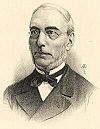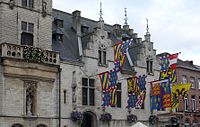Portal:Heraldry
Welcome to the Heraldry and Vexillology Portal!


Vexillology (from the Latin vexillum, a flag or banner) is the scholarly study of flags, including the creation and development of a body of knowledge about flags of all types, their forms and functions, and of scientific theories and principles based on that knowledge. Flags were originally used to assist military coordination on the battlefield, and have evolved into a general tool for signalling and identification, particularly identification of countries.
Heraldry encompasses all of the duties of a herald, including the science and art of designing, displaying, describing and recording coats of arms and badges, as well as the formal ceremonies and laws that regulate the use and inheritance of arms. The origins of heraldry lie in the medieval need to distinguish participants in battles or jousts, whose faces were hidden by steel helmets.
Selected article

"England expects that every man will do his duty" was a signal sent by Admiral Horatio Nelson, 1st Viscount Nelson from his flagship HMS Victory as the Battle of Trafalgar was about to commence on October 21, 1805. Trafalgar was the decisive naval engagement of the Napoleonic Wars. It gave the United Kingdom of Great Britain and Ireland control of the seas, removing all possibility of a French invasion and conquest of Britain. Although there was much confusion surrounding the wording of the signal in the aftermath of the battle, the significance of the victory and Nelson's death during the battle led to the phrase becoming embedded in the English psyche, and it has been regularly quoted, paraphrased and referenced up to the modern day. (more...)
Selected flag

The flag of the People's Republic of China is a red field charged in the canton (upper left corner) with five golden stars. The design features one large star, with four smaller stars in a semicircle set off towards the fly (right side). The red represents revolution; the five stars and their relationship represent the unity of the Chinese people under the leadership of the Communist Party of China (CPC). Sometimes, the flag is referred to as the "Five Star Red Flag" (simplified Chinese: 五星红旗; traditional Chinese: 五星紅旗; pinyin: wǔ xīng hóng qí).
The flag was designed in response to a circular distributed by the Preparatory Committee of the New Political Consultative Conference (新政治協商會議籌備會) in July 1949, shortly after they came to power following the Chinese Civil War. About three thousand entries were received for the design competition, and after slight modifications, the design by Zeng Liansong, a citizen from Rui'an, Zhejiang, was chosen as the national flag. The construction sheet for the national flag was published on September 28, 1949 by an order from the Presidium of the First Plenary Session of the Chinese People's Political Consultative Conference. The first flag was hoisted by Mao Zedong on a pole overlooking Beijing's Tiananmen Square on October 1, 1949, at a ceremony announcing the founding of the People's Republic. (more...)
Selected biography

Johannes Baptista Rietstap (12 May 1828–24 December 1891) was a Dutch heraldist and genealogist, who is often considered to be the father of modern heraldry in the Netherlands. Rietstap was proficient in English, French, German, Spanish and Latin in addition to his mother tongue, and from the 1850s to the 1870s published a large number of translations of both fiction and non-fiction works. He also worked as a stenographer for the Staten-Generaal for 37 years, eventually rising to the position of First Stenographer. He is most well-known however for his publication of the Armorial Général. This monumental work contains the blazons of the coats of arms of more than 130,000 European families, and is still one of the most complete works of its kind. (more...)
Selected picture

The town hall of Dendermonde, a city in Flanders, displaying heraldic banners.
Did you know...
- ...that, among the flags of Romania, the removal of the socialist coat of arms during the Romanian Revolution of 1989 gave rise to the phrase "the flag with the hole" (pictured)?
- ...that the designer of the Coat of arms of New South Wales, William Gullick, was also responsible for heraldic influences in postage stamp design?
- ...that a bumerke is a house mark with relation to coats of arms as it was frequently used instead of them and used with a shield as a frame work for the mark?
- ...that the Guilford Courthouse flag is the oldest surviving example of an American flag with eight-pointed stars?
- ...that President Lyndon Johnson was granted a coat of arms by the American College of Heraldry and Arms in 1968?
Related portals
|
|
|
Heraldry Web resources
Authorities
- Belgium - The Council of Nobility, Flemish Heraldic Council and Council of Heraldry and Vexillology of the French Community
- Canada - Canadian Heraldic Authority and see also Public Register of Arms, Flags and Badges
- England, Wales, and Northern Ireland - The College of Arms
- Ireland - The Office of the Chief Herald of Ireland
- Netherlands - High Council of Nobility
- Portugal - Instituto da Nobreza Portuguesa
- Scotland - The Court of the Lord Lyon
- South Africa - South African Bureau of Heraldry
- Sweden - National Board of Heraldry, The National Archive
- United States Army - The United States Army Institute of Heraldry
Societies
- Greek Heraldry Society
- The Academy of Heraldic Science Czech republic
- The American College of Heraldry
- The American Heraldry Society
- The Augustan Society
- The Australian Heraldry Society Inc.
- Bulgarian Heraldry and Vexillology Society
- The Center for Research of Orthodox Monarchism
- Cambridge University Heraldic and Genealogical Society
- Chiltern Heraldry Group
- The College of Dracology
- Croatian Heraldic and Vexillologic Association
- The Finnish Heraldic Society
- Fryske Rie foar Heraldyk
- Hellenic Armigers Society
- Guild of Heraldic Artists
- Genealogical Society of Ireland
- Heraldry Research Institute (Japan)
- The Heraldry Society
- The Heraldry Society of Africa
- The Heraldry Society of New Zealand Inc.
- The Heraldry Society of Scotland
- The Heraldry Society of Southern Africa
- The Institute of Heraldic and Genealogical Studies
- The International Association of Amateur Heralds
- Italian Center of Vexillological Studies
- Lancashire Heraldry Group
- Macedonian Heraldry Society
- New England Historic Genealogical Society Committee on Heraldry
- Norwegian Heraldry Society
- Oxford University Heraldry Society
- Polish Heraldry Society
- Polish Nobility Confederation
- Real Academia Matritense de Heráldica y Genealogía - Royal Academy of Heraldry and Genealogy of Madrid
- Romanian Institute for Genealogy and Heraldry
- The Royal Heraldry Society of Canada
- The Russian College of HeraldryThe Russian College of Heraldry
- Serbian Heraldic Society
- Societas Heraldica Scandinavica
- Societas Heraldica Slovenica
- Swedish Heraldic Society
- Ukrainian Heraldry Society
- Royal Association Genealogical and Heraldic Office of Belgium
Vexillology
Software
- Coat of Arms Visual Designer web-based program
- Puncher Heraldry Program
- Blazonry Server - pyBlazon
- DrawShield - creates SVG shield or arms image from blazon
- CoaMaker - web-based tool
- Blazon95 and BLAZONS! 2000, older Windows applications
Texts
- Heraldry, historical and popular : with seven hundred illustrations (1863)
- A Complete Guide to Heraldry (1909)
Other
Wikimedia
The following Wikimedia Foundation sister projects provide more on this subject:
-
Commons
Free media repository -
Wikibooks
Free textbooks and manuals -
Wikidata
Free knowledge base -
Wikinews
Free-content news -
Wikiquote
Collection of quotations -
Wikisource
Free-content library -
Wikispecies
Directory of species -
Wikiversity
Free learning tools -
Wikivoyage
Free travel guide -
Wiktionary
Dictionary and thesaurus












